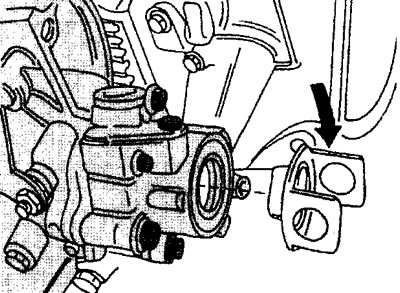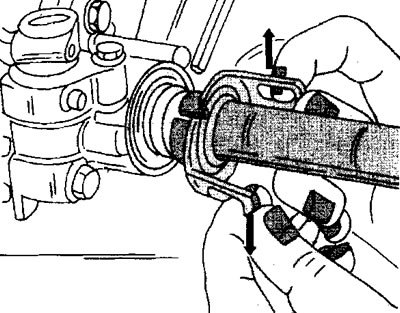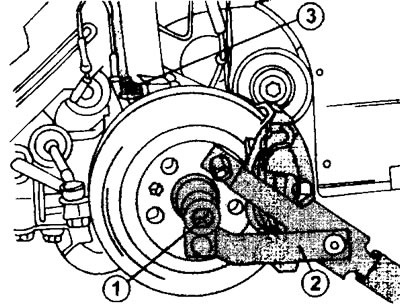13. Grease a working surface of a new epiploon and hammer an epiploon into a hole. The oil seal must stand so that its outer surface is flush with the surface of the gearbox housing. It must be remembered that the dimensions of the seals of the shank of the outer CV joint and the inner one differ in their diameters.
The installation of drive shafts is carried out depending on the shaft.
Drive shaft without support bearing
14. Insert the protective guide, if supplied with the oil seals, into the hole for the shaft shank on the gearbox (see illustration). Insert the shank of the inner CV joint into the same hole so that the splines of the shaft are aligned with the gear teeth.

7.14 Insert a guide to protect the oil seal from damage when installing the drive shaft
15. Remove the protective rail by pulling on the side tabs (see illustration).

7.15 Remove the protective rail by pulling on the side tabs
Drive shaft with thrust bearing
16. Check the travel of the thrust bearing and make sure it does not have excessive play. Replace bearing if necessary.
17. Replace with a new dust ring if the old one is not in good condition.
18. Lightly lubricate the support bearing outer race and dust seal.
19. Insert the inner end of the drive shaft through the support bearing hole, and then put the dust ring on it. The flat side of the dust ring must face the gearbox.
20. Insert the shaft shank into the hole on the gearbox. Pre-install the guide that protects the oil seal in the gearbox from damage, if any. If at the same time the outer ring of the support bearing comes out of the housing, then the ring must be hammered into place with a hammer with a soft metal striker.
21. Be convinced that the basic bearing costs correctly and turn back on a quarter of a turn bolts of fastening of the bearing.
22. Tighten the nuts of the bolts with a torque of 10 Nm (see illustration 7.9).
23. Make sure the driveshaft dust ring is tight against the gearbox.
All types of drive shafts
24. Insert the outer end of the drive shaft into the steering knuckle and hub until it stops.
25. Give a rotary fist in the inside and connect its top with the lower part of an amortization rack.
26. Insert the tie bolts into the holes, observing the marks indicating which side the bolt heads should be on. Screw the nuts onto the bolts and tighten them with a torque of 110 Nm.
27. Reinstall, if available, the ABS sensor.
28. Thread a new nut onto the hub axle, but do not tighten it.
29. Lower the vehicle and apply the parking brake.
30. Screw in the nuts of both hubs using a replaceable socket, and then tighten to the required tightening torque of 100 Nm using a torque wrench. From this position tighten the nuts by 60° (see illustration).

7.30 Tightening the hub nut
1 - end head
2 - stop to keep the hub from turning
3 - bolts of fastening of a rotary fist and an amortization rack
31. Install a slotted lock washer on the hub nut and insert the cotter pin (see illustration 7.3). It goes without saying that the hole on the lock washer and nut must match.
32. Tighten the wheel nuts.
33. Fill the gearbox with gear oil or add the required amount, depending on whether the oil was completely or partially drained.
